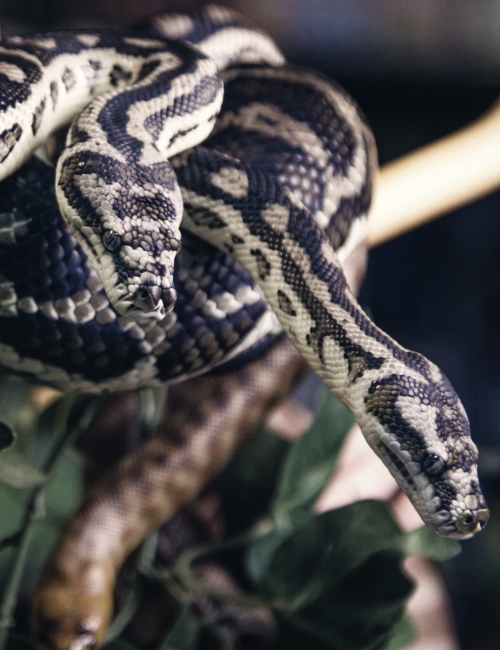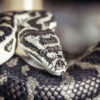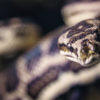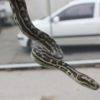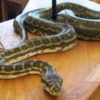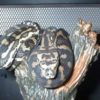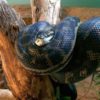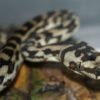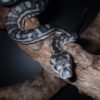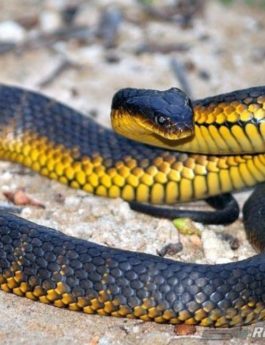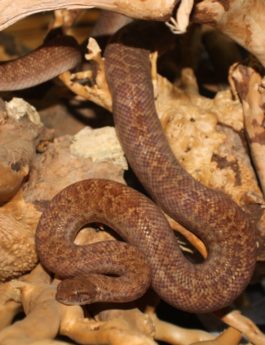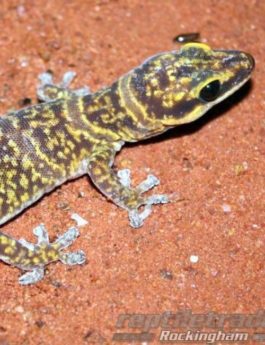Large distinctive python with small fragmented head shields. Four subspecies are currently recognised though a number of distinctly patterned populations occur. It remains to be demonstrated whether these represent additional subspecies or mere colour variants. M. s. spilota (Diamond Python) (Lacépède, 1804) represents the species in eastern N.S.W., from Northern Rivers south to north-eastern Vic: Ground colour dark grey to black. Most scales bear a cream spot. Clusters of all cream or predominantly cream scales form roughly diamond-shaped blotches over back and flanks.
Shelters in hollow trunks and limbs, disused burrows, caves, rock-crevices and beneath boulders. Often encountered on rafters and in ceilings of buildings, including those in many urban areas. The subspecies and variants of M. spilota occupy most habitats within their broad distributions. M. s. spilota and M. s. variegata (Widespread Eastern form) occur in virtually all terrains including urban environments. M. s. bredli and M. s. variegata (Eastern Interior form) are commonly associated with large eucalypts along riverbanks, with M. s. bredli also frequently dwelling in riverine gorges. While M. s. imbricata is widespread on the south-western mainland it seems to be most abundant on off-shore islands.
Terrarium: South-West Carpet Pythons are an arboreal snake that can grow to a large size, the enclosure needs to be large enough to provide horizontal logs to bask themselves on, multiple hide rocks and maintain a thermal gradient. A terrarium that is 900x60x120cm (WxDxH) would be suitable to house a mature Carpet Python, for a pair of Mature Carpet Pythons 120x60x120 would provide an enclosure with adequate room for both snakes.
Lighting & heating: UVB lighting is not essential to Carpet Pythons, however a low 2.0 spectrum fluorescent globe can be used for viewing purposes. Heating can be provided with a heat tile, mat or cord to maintain a ground surface temperature of 32°C in the hot spot. Ambient heat can be provided with an infrared heat globe to maintain a daytime temperature of 36°C in the warm end and 25°C in the cool end, on warmer days you may not need to turn on the heat globe as the ambient temperature of the enclosure may already be high enough. A thermometer should always be used to monitor the temperature within the enclosure.
Furnishings: It is important to provide your Carpet Python with a large enough of hide cave, a water bowl at the cool end, and artificial plants will give coverage and decoration. Large horizontal Logs and vines can be used within the enclosure to provide climbing enrichment. A pet bedding wood chips such as Chipsi or Critter Crumble can be used as a substrate.
Food in captivity: All captive bred snakes must be fed dead food. A Carpet Python will eat a variety of frozen and thawed mice, rats and chickens of appropriate sizes. On average they will have 1-2 food items every 7-10 days.
The essentials:
- Terrarium of appropriate size
- Tummy heating
- Thermometer
- Infrared Heat globe
- Water bowl
- Substrate
- Hide caves
- Foliage for shelter
- Large logs

